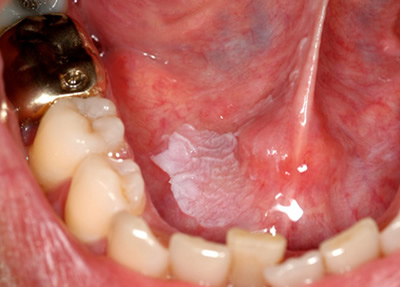White Patches in the Mouth

White patches in the mouth may develop due to many causes including trauma, infection, immunological conditions, congenital conditions and cancer.
White patches due to trauma include frictional keratosis which very commonly forms in sites of chronic irritation. Also chemical burns may occur due to topical application of aspirin.
Fungal infections may cause white patches. Pseudomembranous candidosis (thrush) is characterised by creamy-yellow patches, often on the soft palate, which wipe off. Chronic hyperplastic candidosis, which usually occurs in smoker's, may appear as thickened white plaques often near the corners of the mouth. When a fungal infection is suspected swabs and saliva samples may be useful to confirm the diagnosis. Sometimes blood tests may be required to exclude an underlying cause. Occasionally a biopsy may be indicated. These conditions are treated with general advice and antifungal therapy.
Immunological conditions which may cause white patches in the mouth include oral lichen planus and lichenoid reactions.
Occasionally congenital conditions may cause white patches in the mouth. An example of this is white sponge naevus which often causes a white corrugated appearance at several sites in the mouth and also may involve other sites in the body.
Oral cancer (squamous cell carcinoma) may present as a white patch in the mouth especially in patients who smoke, drink alcohol or chew pan. Cancer of the lower lip may occur due to frequent exposure to sunlight. If an oral cancer is suspected than a biopsy is required.
Leukoplakia is the term used to describe a white patch in the mouth that can not be rubbed off and can not be characterised clinically as any specific disease. Often these are related to smoking. There is a low transformation rate in developed countries of leukoplakia to oral cancer of about 1-2% in 5 years, although this may be higher in other parts of the world. Usually a biopsy would be advised to exclude cancer or changes called dysplasia which would indicate that the lesion needs to be monitored.